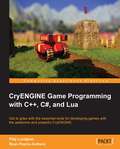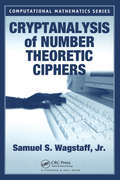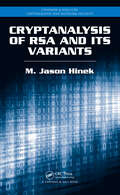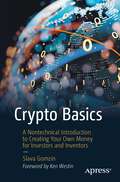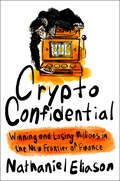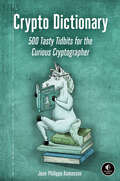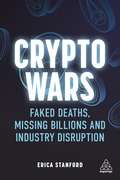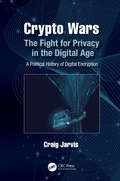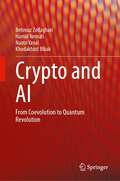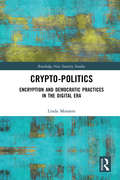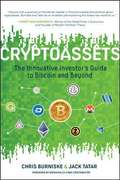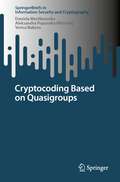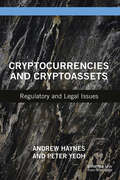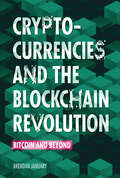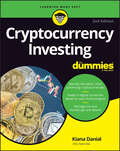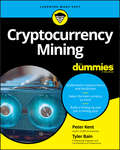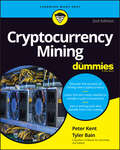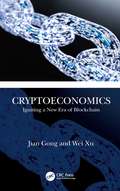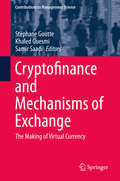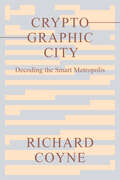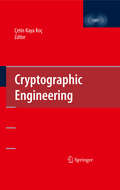- Table View
- List View
CryENGINE Game Programming with C++, C#, and Lua
by Filip Lundgren Ruan Pearce-AuthersThis book provides you with step-by-step exercises covering the various systems of CryENGINE and comprehensively explains their workings in a way that can be easily understood by readers of any skill level to help you develop your very own CryENGINE games.This book is intended for developers looking to harness the power of CryENGINE, providing a good grounding in how to use the engine to its full potential. The book assumes basic knowledge of the engine and its editor in non-programming areas.
Cryogenic Microelectronic Systems for Ultra-Low Energy and Enhanced Performance
by Eby G. Friedman Nurzhan ZhuldassovThis book explores cryogenic computers to achieve faster operation and lower energy use. As computer components become smaller and generate more heat, traditional cooling methods struggle to keep up. By operating at cryogenic temperatures, these limitations can be overcome—reducing heat, improving performance, and opening new possibilities for important applications such as large scale data centers and quantum computers. The approaches and physical models discussed in this book are valuable since these concepts offer a practical methodology for increasing computational computing power without being limited by heat and power dissipation. The book explores how cryogenic temperatures can supercharge computing. Novel methods for designing and optimizing computer systems that operate at extremely low temperatures, improve performance, reduce power consumption, and tackle the fundamental physical limits faced by modern electronics are introduced in this book. From foundational physics-based principles and cryogenic equipment to innovative graph theoretic design, the book offers a fresh look at the future of high performance, energy efficient computing.
Cryptanalysis of Number Theoretic Ciphers (Computational Mathematics)
by Samuel S. Wagstaff, Jr.At the heart of modern cryptographic algorithms lies computational number theory. Whether you're encrypting or decrypting ciphers, a solid background in number theory is essential for success. Written by a number theorist and practicing cryptographer, Cryptanalysis of Number Theoretic Ciphers takes you from basic number theory to the inner workings of ciphers and protocols.First, the book provides the mathematical background needed in cryptography as well as definitions and simple examples from cryptography. It includes summaries of elementary number theory and group theory, as well as common methods of finding or constructing large random primes, factoring large integers, and computing discrete logarithms. Next, it describes a selection of cryptographic algorithms, most of which use number theory. Finally, the book presents methods of attack on the cryptographic algorithms and assesses their effectiveness. For each attack method the author lists the systems it applies to and tells how they may be broken with it.Computational number theorists are some of the most successful cryptanalysts against public key systems. Cryptanalysis of Number Theoretic Ciphers builds a solid foundation in number theory and shows you how to apply it not only when breaking ciphers, but also when designing ones that are difficult to break.
Cryptanalysis of RSA and Its Variants (Chapman & Hall/CRC Cryptography and Network Security Series)
by M. Jason HinekThirty years after RSA was first publicized, it remains an active research area. Although several good surveys exist, they are either slightly outdated or only focus on one type of attack. Offering an updated look at this field, Cryptanalysis of RSA and Its Variants presents the best known mathematical attacks on RSA and its main variants, includin
Crypto Basics: A Nontechnical Introduction to Creating Your Own Money for Investors and Inventors
by Slava GomzinUse this practical, step-by-step guide for developers and entrepreneurs to create and run your own cryptocurrency. Author Slava Gomzin has created two cryptocurrencies and describes in this book the technology and economics of cryptocurrencies as preparation for crypto trading, investing, and other business activities. A detailed overview of special topics includes security, privacy, and usability of crypto as a mainstream payment system. Part I, Understanding Crypto, explains the technology and economic, security, and usability aspects of crypto. This is an introduction to the world of cryptography, blockchain tech, and other elements of crypto such as security, privacy, and a detailed review of payment processing.Part II, Using Crypto, provides the practical knowledge you need to dive into the crypto business such as investment, trading, and even creating your own crypto project.Part III, Creating Your Own Crypto, teaches you how to launch your own crypto project and create your own cryptocurrency.What You Will Learn Know how cryptography, Bitcoin, and other cryptos workUnderstand how crypto becomes money, and how crypto exchanges workUse crypto as a payment methodBuy your first crypto and know what exchange you should useBe aware of the most dangerous crypto attacks and what to do about security and privacyMaintain anonymity and privacy while dealing with cryptoKnow how Monero (the most popular privacy-centric cryptocurrency) worksCreate and run your own crypto projectCreate your own token, both regular (fungible) and NFT (non-fungible), from selecting the platform to economics and finances Who This Book Is For Crypto inventors, entrepreneurs, developers, investors, and advisors who are thinking about creating their own cryptocurrency; traders and investors, both professional and amateur, looking to enter the crypto markets; and software architects, developers, managers, consultants, executives, and crypto enthusiasts working for merchants, banks, fintech companies, and many other businesses that have started accepting crypto payments or dealing with other aspects of crypto
Crypto Confidential: Winning and Losing Millions in the New Frontier of Finance
by Nathaniel EliasonTHE WILD INSIDE STORY OF CRYPTO'S GET-RICH-QUICK UNDERBELLYNat Eliason had six months to make as much money as possible before his first child was born. So, he turned to where countless others did in 2021: Crypto. Within a year, he'd made millions writing code holding hundreds of millions of dollars of other people's money. He'd been hacked. He'd sold a picture of a monkey for two hundred grand. He'd become an influencer, speaking at conferences, and writing a weekly newsletter to tens of thousands of fans. Best of all, Nat had amassed a small fortune. But how much of this money was even real? And how many times can someone double down before they eventually lose everything? Crypto Confidential is Nat's unfiltered, insider's account of the hyperactive, hyper-speculative, hyper-addictive, nearly unregulated, completely insane world being built on the blockchain. A behind-the-scenes exposé of the bull runs and breakdowns, revealing exactly how the crypto-sausage gets made. A story of getting rich, going broke, scamming and getting scammed— and how we can all be more educated participants during the inevitable next bull run.
Crypto Dictionary: 500 Tasty Tidbits for the Curious Cryptographer
by Jean-Philippe AumassonRigorous in its definitions yet easy to read, Crypto Dictionary covers the field of cryptography in an approachable, and sometimes humorous way.Expand your mind and your crypto knowledge with the ultimate desktop dictionary for all things cryptography. Written by a renowned cryptographer for experts and novices alike, Crypto Dictionary is rigorous in its definitions, yet easy to read and laced with humor. Flip to any random page to find something new, interesting, or mind-boggling, such as: • A survey of crypto algorithms both widespread and niche, from RSA and DES to the USSR&’s GOST cipher • Trivia from the history of cryptography, such as the MINERVA backdoor in Crypto AG&’s encryption algorithms • An explanation of why the reference to the Blowfish cipher in the TV show 24 makes absolutely no sense • Types of cryptographic protocols like zero-knowledge; security; and proofs of work, stake, and resource • A polemic against referring to cryptocurrency as &“crypto&” • Discussions of numerous cryptographic attacks, including slide and biclique The book also looks toward the future of cryptography, with discussions of the threat quantum computing poses to current cryptosystems and a nod to post-quantum algorithms, such as lattice-based cryptographic schemes. With hundreds of incisive entries organized alphabetically, Crypto Dictionary is the crypto go-to guide you&’ll always want within reach.
Crypto Millionaires: Blockchain: A Chance for All?
by Mateusz MachBlockchain, the key to the world of cryptocurrencies—a phrase that sounds like a promise of wealth. But what exactly is Blockchain? Unfortunately, in most books, articles, and discussions, it is either explained in a way that’s hard to understand or oversimplified with unnecessary emotional baggage, presented either technically or ideologically. Some see Blockchain as a savior from greedy bankers, while others view it as a tool for building cryptocurrencies that undermine central banks. Which image is closer to reality? The story of Blockchain is not just a tale of mathematical experiments. It’s primarily a story of the age-old attempt to record human activities and the value that flows from them. This time, however, the goal is to make it accessible to everyone on equal terms.This book delves into the evolution and technical intricacies of Blockchain technology, steering clear of the common focus on mere cryptocurrency speculation. It clarifies complex concepts and underscores Blockchain’s capacity to revolutionize industries and empower individuals globally, thereby demystifying the technology and making its profound potential accessible to everyone.
Crypto Wars: Faked Deaths, Missing Billions and Industry Disruption
by Erica StanfordCrypto is big news. You may be an existing user yourself or have friends that laud its promise of getting rich fast. Arm yourself with knowledge to come out on top in the crypto wars. If thousands of people can lose billions of dollars in OneCoin, masterminded by the now infamous Missing Cryptoqueen made famous by the BBC's podcast series and called 'one of the biggest scams in history' by The Times, what makes you think your money is safe? OneCoin isn't alone. Crypto Wars reveals some of the most shocking scams affected millions of innocent people all around the world with everything from religious leaders to celebrities involved. In this book, you get exclusive access to the back story of the most extreme Ponzi schemes, the most bizarre hoaxes and brutal exit strategies from some of the biggest charlatans of crypto.Crypto expert and educator, Erica Stanford, will show you how market-wide manipulation schemes, unregulated processes and a new collection of technologies that are often misunderstood, have been exploited to create the wild west of crypto, run by some less than reputable characters. From OneCoin to PonziCoin to Trumpcoin and everything in between, Crypto Wars uncovers the scandals, unpicks the system behind them and allows you to better understand a new technology that has the potential to revolutionize banking and our world for the better.
Crypto Wars: The Fight for Privacy in the Digital Age: A Political History of Digital Encryption
by Craig JarvisThe crypto wars have raged for half a century. In the 1970s, digital privacy activists prophesied the emergence of an Orwellian State, made possible by computer-mediated mass surveillance. The antidote: digital encryption. The U.S. government warned encryption would not only prevent surveillance of law-abiding citizens, but of criminals, terrorists, and foreign spies, ushering in a rival dystopian future. Both parties fought to defend the citizenry from what they believed the most perilous threats. The government tried to control encryption to preserve its surveillance capabilities; privacy activists armed citizens with cryptographic tools and challenged encryption regulations in the courts. No clear victor has emerged from the crypto wars. Governments have failed to forge a framework to govern the, at times conflicting, civil liberties of privacy and security in the digital age—an age when such liberties have an outsized influence on the citizen–State power balance. Solving this problem is more urgent than ever. Digital privacy will be one of the most important factors in how we architect twenty-first century societies—its management is paramount to our stewardship of democracy for future generations. We must elevate the quality of debate on cryptography, on how we govern security and privacy in our technology-infused world. Failure to end the crypto wars will result in societies sleepwalking into a future where the citizen–State power balance is determined by a twentieth-century status quo unfit for this century, endangering both our privacy and security. This book provides a history of the crypto wars, with the hope its chronicling sets a foundation for peace.
Crypto and AI: From Coevolution to Quantum Revolution
by Khodakhast Bibak Behrouz Zolfaghari Hamid Nemati Naoto YanaiThis book studies the intersection between cryptography and AI, highlighting the significant cross-impact and potential between the two technologies. The authors first study the individual ecosystems of cryptography and AI to show the omnipresence of each technology in the ecosystem of the other one. Next, they show how these technologies have come together in collaborative or adversarial ways. In the next section, the authors highlight the coevolution being formed between cryptography and AI. Throughout the book, the authors use evidence from state-of-the-art research to look ahead at the future of the crypto-AI dichotomy. The authors explain how they anticipate that quantum computing will join the dichotomy in near future, augmenting it to a trichotomy. They verify this through two case studies highlighting another scenario wherein crypto, AI and quantum converge. The authors study current trends in chaotic image encryption as well as information-theoretic cryptography and show how these trends lean towards quantum-inspired artificial intelligence (QiAI). After concluding the discussions, the authors suggest future research for interested researchers.
Crypto-Politics: Encryption and Democratic Practices in the Digital Era (Routledge New Security Studies)
by Linda MonseesThis book examines current debates about the politics of technology and the future of democratic practices in the digital era. The volume centres on the debates on digital encryption in Germany and the USA, during the aftermath of Edward Snowden’s leaks, which revolved around the value of privacy and the legitimacy of surveillance practices. Using a discourse analysis of mass media and specialist debates, it shows how these are closely interlinked with technological controversies and how, as a result, contestation emerges not within one public sphere but within multiple expert circles. The book develops the notion of ‘publicness’ in order to grasp the political significance of these controversies, thereby making an innovative contribution to Critical Security Studies by introducing digital encryption as an important site for understanding the broader debates on cyber security and surveillance. This book will be of much interest to students of critical security studies, science and technology studies, and International Relations.
CryptoDad: The Fight for the Future of Money
by J. Christopher GiancarloAn insider's account of the rise of digital money and cryptocurrencies Dubbed "CryptoDad" for his impassioned plea to Congress to acknowledge and respect cryptocurrencies as the inevitable product of a fast-growing technological wave and a free marketplace, Chris Giancarlo is considered one of "the most influential individuals in financial regulation." CryptoDad: The Fight for the Future of Money describes Giancarlo’s own reckoning with the future of the global economy—at the intersection of markets, technology, and public policy—and lays out the fight for a Digital Dollar. CryptoDad is Giancarlo's own personal story, detailing his forays into the world of Wall Street to his tenure as the 13th Chairman of the United States Commodity Futures Trading Commission (CFTC), where he pushed for the agency to recognize the digitization of markets. His growing fame as a Twitter presence in this essential debate has given Giancarlo a platform to makes a case for the future of cryptocurrencies as the natural successor to America’s current failing financial market infrastructure. CryptoDad provides readers with: A thorough exploration of digital change and how it affects the lives of everyone in a global economy A revolutionary consideration of regulatory responses to the rapid pace of technological innovation A call to update our aging financial organizations, particularly the infrastructure of money itself, and focus on renewed faith and confidence in free market innovation A foreword by Cameron and Tyler Winklevoss, two of the biggest names in cryptocurrencies CryptoDad argues that the next digital wave will be the coming Internet of Value, where cryptocurrencies will do the Internet of Information did to immaterial things: make them accessible, distributable, and movable instantly across the globe. This book is an ideal introduction to the importance of technology in the marketplace.
Cryptoassets: The Innovative Investor's Guide to Bitcoin and Beyond
by Chris Burniske Jack TatarThe innovative investor’s guide to an entirely new asset class from Chris Burniske and Jack Tatar. <P><P>With the rise of bitcoin and blockchain technology, investors can capitalize on the greatest investment opportunity since the Internet. Bitcoin was the first cryptoasset, but today there are over 800 and counting, including ether, ripple, litecoin, monero, and more. <P><P>This clear, concise, and accessible guide from two industry insiders shows you how to navigate this brave new blockchain world’and how to invest in these emerging assets to secure your financial future.
Cryptocoding Based on Quasigroups (SpringerBriefs in Information Security and Cryptography)
by Verica Bakeva Daniela Mechkaroska Aleksandra Popovska-MitrovikjThis book presents the concept of cryptcoding which arises from the need to obtain secure and accurate transmission. Therefore, it is necessary to improve constantly existing and develop new algorithms that will ensure accurate and secure data transfer. This leads to the intensive development of coding theory and cryptography as scientific fields which solve these problems. To ensure efficient and secure data transmission at the same time, the concept of cryptcoding is developed such that the coding and encryption processes are merged into one process. Cryptcodes provide correction of a certain number of errors in the transmitted message and data confidentiality, using only one algorithm. The main research in this field is to define new algorithms for coding that detects and corrects errors, random codes, stream ciphers, block ciphers, pseudo-random generators, hash functions, etc. This monograph examines an application of quasigroups for designing error-correcting cryptcodes, called Random Codes Based on Quasigroups (RCBQ ). These codes are a combination of cryptographic algorithms and error-correcting codes and depend on several parameters. Some modifications (new coding/decoding algorithms) of RCBQ for improving their performances for transmission ordinary messages, images, and audio files trough a binary-symmetric channel, Gaussian channel, and burst channels are considered. Also, authors propose and analyze filter for visually enhance of the decoded images and improving the quality of decoded audio files.
Cryptocurrencies and Cryptoassets: Regulatory and Legal Issues
by Andrew Haynes Peter YeohThis book examines the legal and regulatory aspects of cryptocurrency and blockchain and the emerging practical issues that these issues involve. The analysis covers a range of advanced economies across the world, in America, Europe and Asia. The book describes, explains and analyses the nature of cryptocurrencies and the blockchain systems they are constructed on in these major world economies and considers relevant law and regulation and their shortcomings. It will be of use and interest to academics, lawyers, regulators and anyone involved with cryptocurrencies and blockchain.
Cryptocurrencies and the Blockchain Revolution: Bitcoin and Beyond
by Brendan JanuaryIn January 2009, a mysterious software developer, Satoshi Nakamoto, exchanged a specially designed code with another developer. The code was a digital currency that Nakamoto had proposed several months before in a paper titled “Bitcoin: A Peer-to-Peer Electronic Cash System.” This was the first Bitcoin transaction. Since then, Bitcoin has become the face of a tech revolution in digital cryptocurrencies based on blockchain technology. Its success has sparked a tech revolution that could fundamentally change global economics. Author Brendan January delves into the world of coders, libertarians, criminals, financial regulators, and crypto-detectives to understand what digital cryptocurrencies have to offer, their limitations and potential pitfalls, security issues, and how they may affect government and financial regulations in the future.
Cryptocurrency Investing For Dummies
by Kiana DanialFrom Bitcoin to Solana, the safe and secure way to invest in cryptocurrencies Cryptocurrency Investing For Dummies, the bestselling guide to getting into the exciting world of crypto, is updated for today’s cryptocurrency markets. Currencies like Bitcoin, Ethereum, Solana, and XRP are gaining popularity, and this trusted guide can help you strike while the iron is hot to profit from the explosive growth in cryptocurrency. We’ll help you understand decentralized currency, get started with leading crypto exchanges and brokers, learn techniques to buy and sell, and strategize your crypto portfolio. You’ll even dig into the details on cryptocurrency tax laws and new opportunities for investors. Gain the tools you need to succeed in the cryptocurrency market Learn about the newest cryptocurrencies on the market and how to evaluate them Develop a strategy for reaping outsized gains using crypto exchanges Understand how cryptocurrencies interact with virtual worldsThis is the perfect Dummies guide for investors who are new to the cryptocurrency market or first-time investors who want to add cryptocurrency to their portfolio. Get started on your crypto adventure.
Cryptocurrency Mining For Dummies
by Peter Kent Tyler BainFind out the essentials of cryptocurrency mining The cryptocurrency phenomenon has sparked a new opportunity mine for virtual gold, kind of like the prospectors of a couple centuries back. This time around, you need some tech know-how to get into the cryptocurrency mining game. This book shares the insight of two cryptocurrency insiders as they break down the necessary hardware, software, and strategies to mine Bitcoin, Ethereum, Monero, LiteCoin, and Dash. They also provide insight on how to stay ahead of the curve to maximize your return on investment. Get the tech tools and know-how to start mining Pick the best cryptocurrency to return your investment Apply a sound strategy to stay ahead of the game Find cryptocurrency value at the source From the basics of cryptocurrency and blockchain to selecting the best currency to mine, this easy-to-access book makes it easy to get started today!
Cryptocurrency Mining For Dummies
by Peter Kent Tyler BainUntangle the steps to mine crypto, including new coins and services The cryptocurrency market moves quickly and miners and investors need the latest information to stay ahead of the game. This edition of Cryptocurrency Mining For Dummies has the insight you need to get started with mining. You'll learn what goes into building a mining rig that can complete cryptocurrency transactions and reap the rewards in the form of new coin. You also discover how to join existing mining programs. Whatever your crypto goals, Dummies will make it easy for you to understand, engage in, and invest in mining. You'll even get an up-to-date primer on the evolving legal situation and an idea of what to expect in the future of crypto. Understand the basics of mining cryptocurrency and get started with your own mining operation Explore the latest cryptocurrencies and mining services so you can mine your own or invest wisely Get involved in crypto mining with the hardware you already have, or build a new, powerful mining machine Become an expert on the latest mining trends so you can identify new ways to profit in the crypto space With this book, you've got insider advice on choosing which cryptos to mine, riding out market fluctuations, creating pool accounts, and more. There's no time like the present to get started with crypto mining.
Cryptocurrency: How I Turned $400 Into $100,000 By Trading Cryprocurrency In 6 Months
by Chris Lambert<p>In this book I want to introduce you to the incredible opportunities cryptocurrencies are bringing into our markets today and, more importantly, how you can take advantage of them to multiply your investments. In the first chapters I will provide you with a fundamental understanding of cryptocurrencies and the current state Blockchain technology. <p>After covering fundamental background knowledge, we will dive into real hands-on experience. I will show you how to purchase cryptocurrencies using today's most effective online Exchange platforms and how to store them securely and safely using an eWallet. Finally, in the last section of the book I will discuss the future of the market. In this section I will show you how to evaluate the potential of a new cryptocurrency and what investment strategies you can employ to achieve the highest returns. <p>Please understand this book will not make you an expert trader in cryptocurrencies. I challenge any single book to make this claim - today's cryptocurrency market is a new and extremely complicated space that is constantly evolving and reshaping in unexpected ways. There are still many unexplored paths and a vast amount of concepts to prove.</p>
Cryptoeconomics: Igniting a New Era of Blockchain
by Wei Xu Jian Gong"A systematic review of the structure and context of the blockchain-derived economic model... (the book) describes cryptoeconomics in connection with the game theory, behavioral economics and others in simple understandable language."—Wang Feng, founder of Linekong Interactive Group and Mars Finance, partner in Geekbang Venture Capital Blockchain technology has subverted existing perceptions and is the start of an economic revolution, called, cryptoeconomics. Blockchain is a key component of cryptoeconomics. Vlad Zamfir, a developer of Ethereum, defines this term as "a formal discipline that studies protocols that governs the production, distribution, and consumption of goods and services in a decentralized digital economy. Cryptoeconomics is a practical science that focuses on the design and characterization of these protocols". This book explains the structures of blockchain-derived economic models, their history, and their application. It uses real-world cases to illustrate the relationship between cryptoeconomics and blockchain. Blockchain technology solves trust issues. A blockchain application can restrict behavior on the blockchain through a reward and punishment system that enables consensus in an innovative way. The greatest significance of cryptoeconomics lies in guaranteeing safety, stability, activity, and order in a decentralized consensus system. Security and stability are achieved mainly by cryptographical mechanisms. Activity and order are achieved through economic mechanisms. Cryptoeconomics and Blockchain: Ignighting a New Era of Blockchain discusses the most popular consensus algorithms and optimization mechanisms. With examples explained in clear and simple terms that are easy to understand, the book also explores economic mechanisms of blockchain such as game theory and behavioral economics.
Cryptofinance and Mechanisms of Exchange: The Making of Virtual Currency (Contributions to Management Science)
by Stéphane Goutte Khaled Guesmi Samir SaadiThis book describes how the rapid advancement in encryption and network computing gave birth to new tools and products that have influenced the local and global economy alike. One recent and notable example is the emergence of virtual currencies (such as Bitcoin) also known as cryptocurrencies. Virtual currencies introduced a fundamental transformation that affected the way goods, services and assets are exchanged. As a result of its distributed ledgers based on blockchain, cryptocurrencies not only offer some unique advantages to the economy, investors, and consumers, but also pose considerable risks to users and challenges for regulators when fitting the new technology into the old legal framework. The core of this proposed book is to present and discuss the evidence on financial asset capabilities of virtual currencies. The contributors of this volume analyze several interesting and timely issues such as the particularities of virtual currencies and their statistical characteristics; the diversification benefits of virtual currencies; the behavior and dependence structure between virtual currencies and the financial markets; the economic implications of virtual currencies, their effects, their price risk, and contagion spillovers in a unified and comprehensive framework; the future of virtual currencies and their distributed ledgers technology.
Cryptographic City: Decoding the Smart Metropolis
by Richard CoyneCryptography&’s essential role in the functioning of the city, viewed against the backdrop of modern digital life.Cryptography is not new to the city; in fact, it is essential to its functioning. For as long as cities have existed, communications have circulated, often in full sight, but with their messages hidden. In Cryptographic City, Richard Coyne explains how cryptography runs deep within the structure of the city. He shows the extent to which cities are built on secrets, their foundations now reinforced by digital encryption and cryptocurrency platforms. He also uses cryptography as a lens through which to inspect smart cities and what they deliver. Coyne sets his investigation into the cryptographic city against the backdrop of the technologies, claims, and challenges of the smart city.Cryptography provides the means by which communications within and between citizens and devices are kept secure. Coyne shows how all of the smart city innovations—from smart toasters to public transportation networks—are enabled by secure financial transactions, data flows, media streaming, and communications made possible by encryption. Without encryption, he says, communications between people and digital devices would be exposed for anyone to see, hack, and misdirect. He explains the relevant technicalities of cryptography and describes the practical difference it makes to frame cities as cryptographic. Interwoven throughout the book are autobiographical anecdotes, insights from Coyne&’s teaching practice, and historical reports, making it accessible to the general reader.
Cryptographic Engineering
by Cetin Kaya KocThis book is for engineers and researchers working in the embedded hardware industry. This book addresses the design aspects of cryptographic hardware and embedded software. The authors provide tutorial-type material for professional engineers and computer information specialists.
